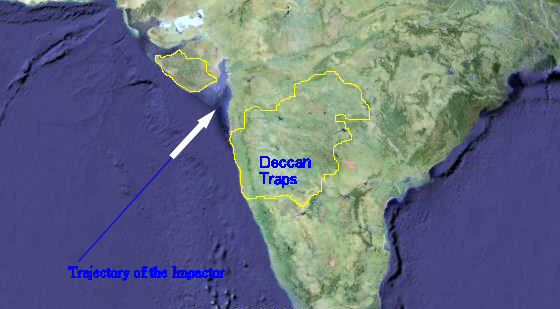The meteoric impact that wiped out the non-bird-line dinosaurs is an iconic image of life and death on Earth. It signifies a point in time when life changed forever. It took from us animals that we will never see again.
But was it just a single strike that created these winds of permanent change? The crater from Chicxulub in Mexico is the scapegoat for taking dinosaurs from us, but did it have a partner in crime?
Weighing in at about 180km in diameter, the Chicxulub impact was enormous. Imagine that hitting today – it would be the size of many small countries and islands, and devastate humanity.
But Chicxulub is dwarfed by a 450 by 600km crater in the southern Indian Ocean, known as Shiva. Shiva to some cultures means “The Destroyer”, which would seem an appropriate name for a potential great exterminator, even if it was formed just by a lump of rock and ice.
That’s a pretty massive crater. One of the most well-known features of the Chicxulub strike is the iridium layer at the Cretaceous/Paleogene boundary. Might there be additional evidence of two impacts hidden away?
Layers known as ‘K-T Boundary Clays’ are known from North America, created by the ejecta thrown into the atmosphere from the intensity of the impact strike. However, in western North America, two different ones have been identified, from slightly different times. About 41,000 years, to be precise, based on our understanding of the rates of sediment accumulation and the distance between the two layers. This second, slightly younger layer was caused by Shiva.

Proposed location of the Shiva impact crater (source)
Additional evidence for the Shiva impact comes from spherules, little blebs of molten rock that splash out of the crater upon impact. Four such ‘fields’ of spherules are known from cores from the Pacific. These cores also contain high levels of iridium, as well as ‘shocked’ quartz, formed only from high pressure impacts.
But what does this mean for the timing of the extinction of the dinosaurs? In North America, there is no evidence of dinosaurs after the Chicxulub impact. But in India, dinosaurs disappear abruptly at the Shiva impact, some 41,000 years after Chicxulub.
In that case, Shiva would be responsible for the dinosaur decimation, and knock the Chicxulub impact off its perch as world-killer.
At a quick read of the Wikipedia page (that ever reliable resource), it appears that there’s still a bit of debate as to the authenticity of Shiva being a genuine impact structure. But there’s a lot of evidence in this new study that points towards it being quite real, and most likely responsible for killing off our most beloved of creatures.
It seems then, that The Auspicious One may have been entirely selective in distributing its favours..
Reference: Lerbekmo, J. F. (2014) The Chicxulub-Shiva extraterrestrial one-two killer punches to Earth 65 million years ago, Marine and Petroleum Geology, 49, 203-207

Pingback: Double-whammy signifies the demise of the dinos...
James Witts
I think maybe it hasn’t been picked up because it’s unproven nonsense.. There is not a lot of evidence that Shiva is an impact crater, and the arguments that paper makes about K/Pg boundary debris coming from ‘either’ Shiva or Chicxulub are pretty suspect – I think a quick trip to Google Scholar would produce alternative evidence. Also, the magnetostratigraphy in that paper is odd – I’ve not seen many other studies suggesting a short period of ‘normal’ polarity around the K/Pg.
There are a lot of well-dated, IODP/DSDP cores with K/Pg boundaries, and the deposition of a single layer of impact debris with internal stratigraphy consistent with a single event, and extinction of microfossil floras and faunas – surely the most high-resolution record of the event you will ever get – is both inseparable and geologically instantaneous.
Kyle Freeman
http://www.sciencedirect.com/science/article/pii/S0264817213001372
Original article is here and appears to be open access.
Pingback: Links 3/14/14 | Mike the Mad Biologist